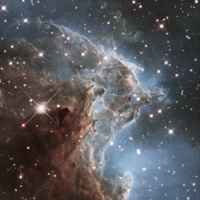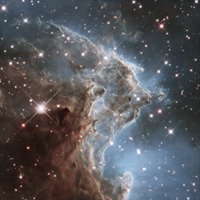NGC 2174
Dublin Core
Title
Subject
Description
In celebration of the 24th anniversary of the launch of NASA's Hubble Space Telescope (on April 24, 1990) astronomers have taken an infrared-light portrait of a roiling region of starbirth located 6,400 light-years away.
The Hubble mosaic unveils a collection of carved knots of gas and dust in a small portion of the Monkey Head Nebula (also known as NGC 2174 and Sharpless Sh2-252). The nebula is a star-forming region that hosts dusky dust clouds silhouetted against glowing gas.
Massive, newly formed stars near the center of the nebula (and toward the right in this image) are blasting away at dust within the nebula. Ultraviolet light from these bright stars helps carve the dust into giant pillars. The nebula is mostly composed of hydrogen gas, which becomes ionized by the ultraviolet radiation.
As the interstellar dust particles are warmed from the radiation from the stars in the center of the nebula, they heat up and begin to glow at infrared wavelengths.
The image demonstrates Hubble's powerful infrared vision and offers a tantalizing hint of what scientists can expect from the upcoming James Webb Space Telescope.
Observations of NGC 2174 were taken in February 2014.
ABOUT THE OBJECT
Object Name:
NGC 2174, Monkey Head Nebula, Sharpless Sh2-252
Object Description:
Star-forming Region
Object Position:
R. A. 06h 9m 10.0s
Dec. 20° 27' 20.0"
Constellation:
Orion
Distance:
6,400 light-years (2,000 parsecs)

